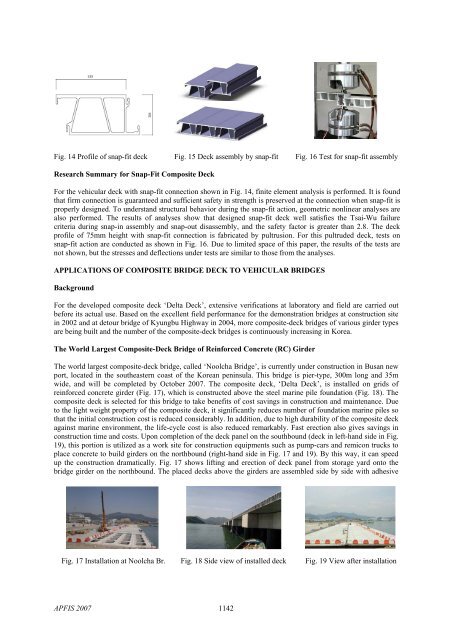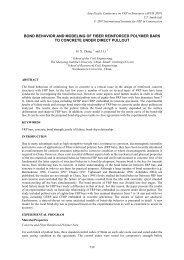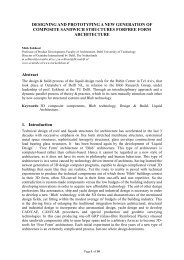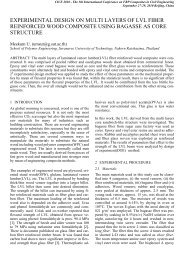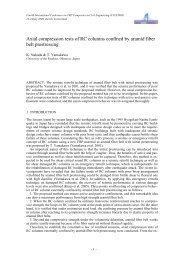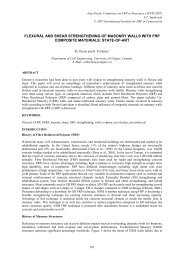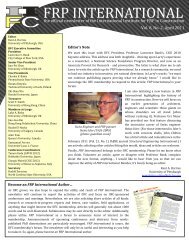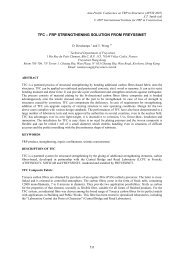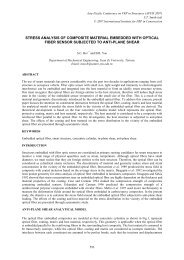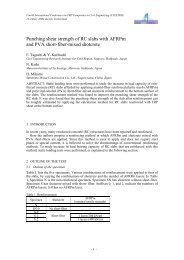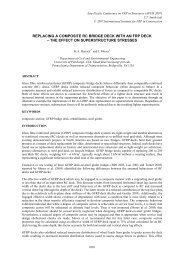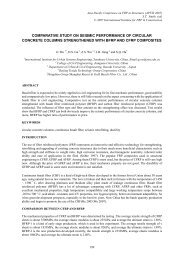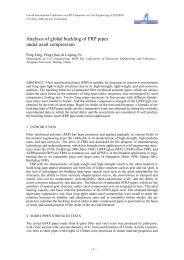construction of 300 m composite-deck bridge in korea
construction of 300 m composite-deck bridge in korea
construction of 300 m composite-deck bridge in korea
You also want an ePaper? Increase the reach of your titles
YUMPU automatically turns print PDFs into web optimized ePapers that Google loves.
Fig. 14 Pr<strong>of</strong>ile <strong>of</strong> snap-fit <strong>deck</strong> Fig. 15 Deck assembly by snap-fit Fig. 16 Test for snap-fit assembly<br />
Research Summary for Snap-Fit Composite Deck<br />
For the vehicular <strong>deck</strong> with snap-fit connection shown <strong>in</strong> Fig. 14, f<strong>in</strong>ite element analysis is performed. It is found<br />
that firm connection is guaranteed and sufficient safety <strong>in</strong> strength is preserved at the connection when snap-fit is<br />
properly designed. To understand structural behavior dur<strong>in</strong>g the snap-fit action, geometric nonl<strong>in</strong>ear analyses are<br />
also performed. The results <strong>of</strong> analyses show that designed snap-fit <strong>deck</strong> well satisfies the Tsai-Wu failure<br />
criteria dur<strong>in</strong>g snap-<strong>in</strong> assembly and snap-out disassembly, and the safety factor is greater than 2.8. The <strong>deck</strong><br />
pr<strong>of</strong>ile <strong>of</strong> 75mm height with snap-fit connection is fabricated by pultrusion. For this pultruded <strong>deck</strong>, tests on<br />
snap-fit action are conducted as shown <strong>in</strong> Fig. 16. Due to limited space <strong>of</strong> this paper, the results <strong>of</strong> the tests are<br />
not shown, but the stresses and deflections under tests are similar to those from the analyses.<br />
APPLICATIONS OF COMPOSITE BRIDGE DECK TO VEHICULAR BRIDGES<br />
Background<br />
For the developed <strong>composite</strong> <strong>deck</strong> ‘Delta Deck’, extensive verifications at laboratory and field are carried out<br />
before its actual use. Based on the excellent field performance for the demonstration <strong>bridge</strong>s at <strong>construction</strong> site<br />
<strong>in</strong> 2002 and at detour <strong>bridge</strong> <strong>of</strong> Kyungbu Highway <strong>in</strong> 2004, more <strong>composite</strong>-<strong>deck</strong> <strong>bridge</strong>s <strong>of</strong> various girder types<br />
are be<strong>in</strong>g built and the number <strong>of</strong> the <strong>composite</strong>-<strong>deck</strong> <strong>bridge</strong>s is cont<strong>in</strong>uously <strong>in</strong>creas<strong>in</strong>g <strong>in</strong> Korea.<br />
The World Largest Composite-Deck Bridge <strong>of</strong> Re<strong>in</strong>forced Concrete (RC) Girder<br />
The world largest <strong>composite</strong>-<strong>deck</strong> <strong>bridge</strong>, called ‘Noolcha Bridge’, is currently under <strong>construction</strong> <strong>in</strong> Busan new<br />
port, located <strong>in</strong> the southeastern coast <strong>of</strong> the Korean pen<strong>in</strong>sula. This <strong>bridge</strong> is pier-type, <strong>300</strong>m long and 35m<br />
wide, and will be completed by October 2007. The <strong>composite</strong> <strong>deck</strong>, ‘Delta Deck’, is <strong>in</strong>stalled on grids <strong>of</strong><br />
re<strong>in</strong>forced concrete girder (Fig. 17), which is constructed above the steel mar<strong>in</strong>e pile foundation (Fig. 18). The<br />
<strong>composite</strong> <strong>deck</strong> is selected for this <strong>bridge</strong> to take benefits <strong>of</strong> cost sav<strong>in</strong>gs <strong>in</strong> <strong>construction</strong> and ma<strong>in</strong>tenance. Due<br />
to the light weight property <strong>of</strong> the <strong>composite</strong> <strong>deck</strong>, it significantly reduces number <strong>of</strong> foundation mar<strong>in</strong>e piles so<br />
that the <strong>in</strong>itial <strong>construction</strong> cost is reduced considerably. In addition, due to high durability <strong>of</strong> the <strong>composite</strong> <strong>deck</strong><br />
aga<strong>in</strong>st mar<strong>in</strong>e environment, the life-cycle cost is also reduced remarkably. Fast erection also gives sav<strong>in</strong>gs <strong>in</strong><br />
<strong>construction</strong> time and costs. Upon completion <strong>of</strong> the <strong>deck</strong> panel on the southbound (<strong>deck</strong> <strong>in</strong> left-hand side <strong>in</strong> Fig.<br />
19), this portion is utilized as a work site for <strong>construction</strong> equipments such as pump-cars and remicon trucks to<br />
place concrete to build girders on the northbound (right-hand side <strong>in</strong> Fig. 17 and 19). By this way, it can speed<br />
up the <strong>construction</strong> dramatically. Fig. 17 shows lift<strong>in</strong>g and erection <strong>of</strong> <strong>deck</strong> panel from storage yard onto the<br />
<strong>bridge</strong> girder on the northbound. The placed <strong>deck</strong>s above the girders are assembled side by side with adhesive<br />
Fig. 17 Installation at Noolcha Br. Fig. 18 Side view <strong>of</strong> <strong>in</strong>stalled <strong>deck</strong> Fig. 19 View after <strong>in</strong>stallation<br />
APFIS 2007 1142


